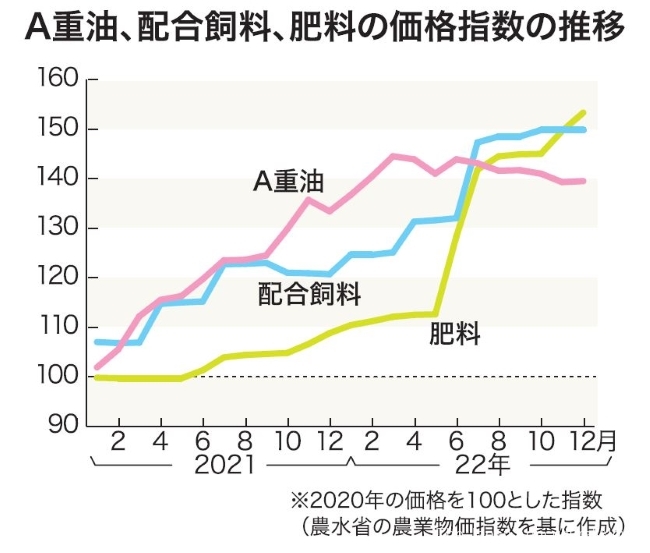 TOKYO, Feb. 1 — The agriculture price index for 2022, released by the agriculture ministry on Jan. 31, showed that the index for production materials was 116.6 with the base year being 2020, which means materials prices rose 16.6 percent in two years.
TOKYO, Feb. 1 — The agriculture price index for 2022, released by the agriculture ministry on Jan. 31, showed that the index for production materials was 116.6 with the base year being 2020, which means materials prices rose 16.6 percent in two years.
The prices marked the highest since 1951 when data became available, up 9.3 percent from the previous year.
The index for fertilizers was 130.5, up 27.1 percent from a year before and that for livestock feed posted 138, up 19.4 percent, pushing up the index for overall production materials.
The agriculture price index shows changes in prices of agricultural production materials and farm produce.
While materials prices soared, the index for farm produce prices was 101.4, rising only 0.6 percent from a year earlier. The index for rice came to 80, down 9.7 percent, indicating that higher costs are not properly passed on to selling prices.
The production material price index for December 2022 was 121.6, rising 0.6 percent from the previous month and 10.4 percent from the same month a year before. The index has been posting a year-on-year increase for 31 consecutive months.
The index for compound feed prices was 149.8 in December, the same as the preceding month but up 24.1 percent from the same month a year earlier.
The rise in feed prices in 2022 were brought about by high demand in such countries as China, as well as reduced distribution of grains due to Russia’s invasion of Ukraine and the yen’s historic fall.
The fertilizer price index was 153.3 in December, increasing 2.5 percent from the previous month and 40.9 percent from the same month a year before.
Prices of fertilizers rose sharply worldwide in 2022, as major exporters of raw materials, such as China and Russia, restricted shipments. The prices kept rising also because of the weakening yen.
Amid the steep rise in crude oil prices globally, utility and energy prices was 127.3 in 2022, up 13.4 percent from the previous year.
The index for type A fuel oil used in greenhouse horticulture for heating stood at 139.5 in December, up 0.1 percent from the previous month and 4.6 percent from the same month a year earlier.
Although prices have dropped in international markets, they remain high in Japan due to the weak yen.

